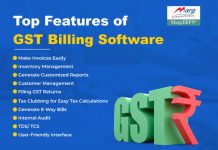The Goods and Services Tax (GST) system in India has been in effect since July 2017. Under this system, businesses are required to file various GST returns, including GSTR-1, which is a return for the outward supplies of goods or services. GSTR-1 is an important document that businesses must file on a monthly or quarterly basis, depending on their turnover. In this article, we will guide you through the process of filing GSTR-1, step by step.
Understanding Of GSTR-1
Understanding GSTR-1: GSTR-1 is a return that captures the details of all outward supplies made during a specific period, including sales, exports, and supplies made to unregistered persons. It also includes details of debit and credit notes issued during the period. GSTR-1 must be filed by all registered persons, except for those who have opted for the composition scheme.
Due Date for Filing GSTR-1: The due date for filing GSTR-1 depends on the turnover of the business. If the turnover is up to Rs. 1.5 crore, GSTR-1 must be filed quarterly, with the due dates being the 13th of the month following the quarter. For businesses with a turnover exceeding Rs. 1.5 crore, GSTR-1 must be filed every month, with the due date being the 11th of the following month.
Steps to File GSTR-1: Filing GSTR-1 involves the following steps:
Step 1: Log in to the GST Portal To file GSTR-1, you need to log in to the GST portal using your credentials, including your username and password.
Step 2: Select ‘Services’ Once you have logged in, you need to select ‘Services’ from the main menu.
Step 3: Click on ‘Returns’ Next, click on ‘Returns’ from the dropdown menu.
Step 4: Select ‘Returns Dashboard’ From the list of returns, select ‘Returns Dashboard’.
Step 5: Select ‘GSTR-1’ From the list of returns available on the dashboard, select ‘GSTR-1’.
Step 6: Fill in the details Once you have selected GSTR-1, you need to fill in the details of your outward supplies, including invoices, debit and credit notes, and advances received.
Step 7: Preview and Submit After filling in all the details, you can preview your return to ensure that all the information provided is correct. Once you are satisfied with the information provided, you can submit your return.
Step 8: File your return using DSC or EVC Finally, you need to file your return using either a digital signature certificate (DSC) or an electronic verification code (EVC).
Common Errors to Avoid:
When filing GSTR-1, there are several errors that businesses commonly make, which can lead to the rejection of the return. Here are some common errors to avoid:
- Incorrect GSTIN
- Incorrect invoice numbers
- Incorrect HSN/SAC codes
- Incorrect tax amounts
- Not reporting all supplies
- Not reporting all invoices
- Not reporting credit or debit notes
- Not reporting advances received
Final Conclusion:
Filing GSTR-1 is an important requirement for all registered businesses under the GST system. By following the steps outlined in this article, businesses can file their returns accurately and on time, and avoid common errors that can lead to the rejection of the return. As a business owner, it is essential to ensure that your GST compliance is up-to-date, and filing GSTR-1 is an important part of this process.
Read more useful content:
Frequently Asked Questions:
Q: What is GSTR-1?
A: GSTR-1 is a return for the outward supplies of goods or services made by registered businesses in India. It is an important document that must be filed on a monthly or quarterly basis, depending on the turnover of the business.
Q: What is the due date for filing GSTR-1?
A: The due date for filing GSTR-1 depends on the turnover of the business. If the turnover is up to Rs. 1.5 crore, GSTR-1 must be filed quarterly, with the due dates being the 13th of the month following the quarter. For businesses with a turnover exceeding Rs. 1.5 crore, GSTR-1 must be filed every month, with the due date being the 11th of the following month.
Q: What are the steps involved in filing GSTR-1?
A: The steps involved in filing GSTR-1 include logging in to the GST portal, selecting ‘Services’, clicking on ‘Returns’, selecting ‘Returns Dashboard’, selecting ‘GSTR-1’, filling in the details of outward supplies, previewing and submitting the return, and filing the return using DSC or EVC.
Q: What are some common errors to avoid when filing GSTR-1?
A: Some common errors to avoid when filing GSTR-1 include incorrect GSTIN, incorrect invoice numbers, incorrect HSN/SAC codes, incorrect tax amounts, not reporting all supplies, not reporting all invoices, not reporting credit or debit notes, and not reporting advances received.
Q: Is it possible to revise GSTR-1 after submission?
A: Yes, businesses can revise GSTR-1 after submission. However, the revision can only be made in the next month’s return and not beyond that.
Q: What happens if GSTR-1 is not filed on time?
A: If GSTR-1 is not filed on time, the business may be liable to pay a late fee of Rs. 50 per day, subject to a maximum of Rs. 5,000.
Q: Can a registered person opt out of filing GSTR-1?
A: No, a registered person cannot opt out of filing GSTR-1. It is a mandatory requirement for all registered persons, except for those who have opted for the composition scheme.
Q: What is the penalty for incorrect filing of GSTR-1?
A: If the details provided in GSTR-1 are found to be incorrect, the business may be liable to pay a penalty of up to Rs. 10,000 or 10% of the tax due, whichever is higher.
Q: Is it necessary to file GSTR-1 for every tax period, even if there are no outward supplies?
A: Yes, even if there are no outward supplies during a tax period, it is necessary to file GSTR-1. The return must be filed with a ‘Nil’ declaration.








